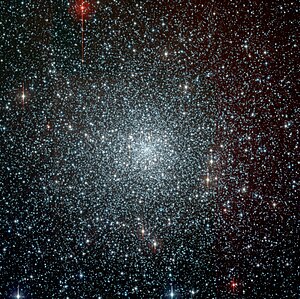NGC 6397
|
Globular cluster NGC 6397 |
|
|---|---|

|
|
| Image taken with the Wide Field Imager (WFI) of the ESO 2.2 m telescope at the La Silla Observatory | |
| AladinLite | |
| Constellation | altar |
|
Position equinox : J2000.0 , epoch : J2000.0 |
|
| Right ascension | 17 h 40 m 41.3 s |
| declination | -53 ° 40 ′ 25 ″ |
| Appearance | |
| Concentration class | IX |
| Brightness (visual) | 5.3 mag |
| Angular expansion | 31 ' |
| Physical data | |
| Integrated spectral type | F4 |
| Redshift | (+6.30 ± 0.03) · 10 −5 |
| Radial velocity | (+18.9 ± 0.1) km / s |
| distance | 7.2 kLj |
| history | |
| discovery | Nicolas Lacaille |
| Discovery date | 1751 |
| Catalog names | |
| NGC 6397 • C 1736-536 • GCl 74 • ESO 181-SC004 • Bennett 98, Caldwell 86, h 3692, GC 4311 | |
NGC 6397 is a globular cluster in the constellation Altar, 7,200 light years away . NGC 6397 has a diameter of 31 arc minutes and an apparent magnitude of 5.3 mag.
NGC 6397 is the second closest globular cluster after M4 and only a little further away than this. In contrast to M4, however, it is not obscured by an interstellar cloud , so the single stars in NGC 6397 are the easiest to observe. It is therefore very often used together with M4 for scientific studies. In one of these investigations, an elliptical galaxy about 1 billion light-years away was found by chance between the stars of NGC 6397, which in turn is surrounded by a swarm of around 200 globular clusters. This is the most distant known collection of globular clusters.
The property was built in 1751 by Nicolas Louis de Lacaille .
Central area as seen with the Hubble Space Telescope
Individual evidence
- ↑ NASA / IPAC EXTRAGALACTIC DATABASE
- ↑ Harlow Shapley, Helen B. Sawyer: A Classification of Globular Clusters . In: Harvard College Observatory Bulletin . tape 849 , 1927, pp. 11-14 , bibcode : 1927BHarO.849 ... 11S .
- ↑ a b SEDS : NGC 6397
- ↑ Seligman


